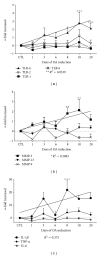Effects of Vitamin D Supplementation during the Induction and Progression of Osteoarthritis in a Rat Model
- PMID: 23118784
- PMCID: PMC3479853
- DOI: 10.1155/2012/156563
Effects of Vitamin D Supplementation during the Induction and Progression of Osteoarthritis in a Rat Model
Abstract
Epidemiological studies correlate low levels of vitamin D with the osteoarthritis (OA) progression. Cytokines and metalloproteases play a major role in OA promoting the inflammation and degradation of the cartilage and can be induced through the Toll-like receptor (TLR) pathway. The aim of this study was to evaluate the protective effect of vitamin D supplementation on the development of osteoarthritis (OA) through examining the genetic regulation of TLRs, cytokines, and metalloproteases in chondrocytes as well as the wideness of cartilage in rats with OA. Our results demonstrate that the signaling through TLR-4 is a proinflammatory mechanism in osteoarthritis that drives the upregulation of MMP-3, IL-1β, and TNF-α gene expression, leading to cartilage degradation and inflammation. Vitamin D supplementation had a protective effect during the onset but not during the chronic stage of OA in the rat model.
Figures





References
-
- Sadeghi K, Wessner B, Laggner U, et al. Vitamin D3 down-regulates monocyte TLR expression and triggers hyporesponsiveness to pathogen-associated molecular patterns. European Journal of Immunology. 2006;36(2):361–370. - PubMed
-
- Haroon M, Bond U, Quillinan N, Phelan MJ, Regan MJ. The prevalence of vitamin D deficiency in consecutive new patients seen over a 6-month period in general rheumatology clinics. Clinical Rheumatology. 2011;30(6):789–794. - PubMed
-
- Bischoff-Ferrari HA, Zhang Y, Kiel DP, Felson DT. Positive association between serum 25-hydroxyvitamin D level and bone density in osteoarthritis. Arthritis & Rheumatism. 2005;53(6):821–826. - PubMed
LinkOut - more resources
Full Text Sources
Miscellaneous

